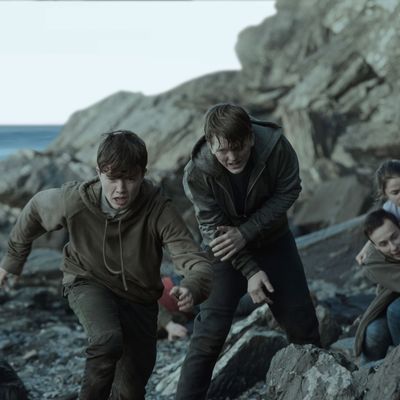
One of the biggest questions that dogs the players of Paul Greengrass’s retelling of the titular 2011 attacks in Norway is how much airtime to give the perpetrator. The white nationalist terrorist Anders Behring Breivik murdered 77 people on that day, 8 in a bombing at an Oslo government building and 69 at a progressive youth leadership camp on the island of Utøya — the deadliest attack in the country since World War II. His actions were horrifying and his xenophobic views, which he expressed with zero remorse after his arrest, were appalling. How much damage would be done just by giving him a trial and the opportunity to air his views in a public forum? By naming him and showing his image continuously on TV, how much was the press disseminating his message?
The same argument quietly haunts Greengrass’s film itself. Greengrass, who has made a name for himself with shaky, unvarnished re-creations of often violent chapters of recent history (in between Bourne installments) seems like the no-brainer choice to tell the story of the 22 July attacks … presuming we need tell them in this format at all. This is not to say that the film Greengrass has created isn’t searing and effective and thought-provoking and all that. But just like the families of the victims in the film who feel nauseous at the prospect of making a celebrity out of Breivik and spreading his toxic ideology, I feel a little queasy at the chilling, captivating portrayal of him by Anders Danielsen Lie. I feel uneasy being “captivated” by any of this, period.
The film is divided into roughly three acts: first, the events of July 21 and 22; second, the longer aftermath and toll of the attacks on the survivors, and the justice system trying to figure out how to handle Breivik; third, Breivik’s trial the following year. The film starts off as an ensemble piece, giving us a cross section of all the different lives affected by the attacks, and then narrows down to the parallel stories of Breivik and his lawyer Geir Lippestad (Jon Øigarden) and teenage survivor Viljar Hanssen’s (Jonas Strand Gravli) long physical and mental recovery and eventual decision to testify at Breivik’s trial. Then-Norwegian prime minister Jens Stoltenberg (Ola G. Furuseth) and his cabinet also play a role, but this is primarily the story of the attacker and his victims, and less so about the political climate and ramifications of the event.
As such, the film sidesteps a lot of the more complex issues on the table, particularly those between Lippestad and Breivik. Breivik requests Lippestad to be his lawyer, and it’s unclear why Lippestad agrees, when it seems he is reasonably nauseated by the very sight of Breivik. He makes the key decision not to make a plea of insanity on the part of his client, which would result in a lesser sentence for the accused. Breivik’s absolute clarity of intention is a foundational premise of Greengrass’s telling, and there is a brief, but crucial sequence in which one of Breivik’s white power heroes is brought to the stand, calmly affirming the existence of a growing international far-right community online.
But because this is a narrative film, that historical context is less important than the fact that the witness disowns Breivik and his actions in court, severing him from the movement he had considered himself a part of and leaving him more isolated than before. 22 July becomes a story not of resisting violent, intolerant ideologies, but the idea of being together (as Viljar and his family and the other survivors of the attack are shown to be) versus alone. That’s all well and good, but in 2018, we know that plenty of the people Breivik claimed to be aligned with in fact have many allies, some even in positions of great political power. It is not terribly convincing to posit Anders as the loser just because he has no friends and Viljar does.
So what else are we to take away from 22 July, from the realistic, terrifying images of a gunman shooting down screaming teenagers in the woods, and the gunman himself as the cool, collected Hannibal Lecter–esque star of the show? I feel like I learned more and understood more about the attacks in reading up on them in preparation for this review; the choice to hire actors to dramatize it is a choice I still can’t quite understand. Greengrass has once again composed a gripping, sometimes unbearably stressful re-creation of horror, so true to life that the “why” of it all is just as inscrutable as life itself.




